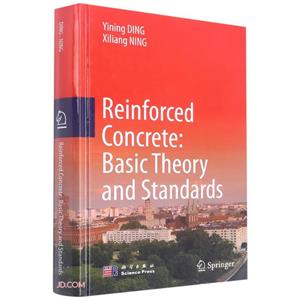中圖網小程序
一鍵登錄
更方便
本類五星書更多>
-
>
了不起的建筑師
-
>
勝景幾何論稿
-
>
中國古代建筑概說
-
>
維多利亞:建筑彩繪
-
>
庭院造園藝術——浙江傳統民居
-
>
建筑園林文化趣味讀本
-
>
磧口古鎮
Reinforced concrete:basic theory and standards 版權信息
- ISBN:9787030729002
- 條形碼:9787030729002 ; 978-7-03-072900-2
- 裝幀:暫無
- 冊數:暫無
- 重量:暫無
- 所屬分類:>>
Reinforced concrete:basic theory and standards 內容簡介
本書基于我國的“混凝土結構設計規范/GB50010-10”,結合的“Fib Model Code for Concrete Structures 10”,ACIV以及EC2(Design of Concrete Structures)中的新理念,主要內括:緒論、材料力學性能、極限狀態設計、鋼筋混凝土梁、受彎截面強度、扭轉構件、受壓構件、受拉構件、使用極限狀態、梁板體系、預應力混凝土。
Reinforced concrete:basic theory and standards 目錄
Introduction
1.1 General Concepts
1.2 History and Development of Reinforced Concrete
1.3 Materials
1.4 Application of Reinforced Concrete
2 Mechanical Behavior of Materials
2.1 Concrete
2.1.1 Grade of Concrete Strength
2.1.2 Axial Compressive Strength
2.1.3 Axial Tensile Strength
2.2 Concrete Behaviors in Compression and Failure Mechanism
2.2.1 Structure of Hardened Concrete
2.2.2 Properties of Concrete Under Short-Term Uniaxial Compressive Loading
2.3 Elasticity Modulus of Concrete Ec and Poisson's Ratio
2.3.1 Modulus of Elasticity of Concrete
2.3.2 Two Methods for Evaluation of Ee
2.3.3 Poisson's Ratio of Concrete
2.4 Constitutive Relation and Deformation of Concrete
2.5 Effect of Lateral Confinement of Transverse Reinforcement on the σ-ε Relationship of Concrete Under Compression
2.6 Mechanical Properties of Concrete Subjected to Multiaxial Stress States
2.7 Time-Dependent Strains of Concrete/Shrinkage and Creep of Concrete
2.7.1 Shrinkage of Concrete
2.7.2 Creep of Concrete
2.8 Reinforcement
2.8.1 Types of Steel Reinforcement
2.8.2 Prestressing Steel Products
2.8.3 Characteristic Strength and Modulus of Elasticity of Reinforcing Steel and Prestressing Steel
2.8.4 Thermal Expansion
2.8.5 Relaxation
2.9 Bond Between Steel and Concrete
3 Limit State Design
3.1 Development of the Design Method
3.2 Limit State of Structure
3.2.1 Limit State Design Based on the Probability Theory
3.2.2 Limit State Design Philosophy
3.2.3 Brief Review of Statistical Concepts
3.3 Function of the Structure
3.3.1 Ultimate Limit State (ULS)
3.3.2 Serviceability Limit State (SLS)
3.4 Action Effect, Resistance Effect, and Reliability
3.4.1 Failure Probability and Reliability
3.4.2 Characteristic Value of Action Effect Sk and Resistance Effect Rk
3.5 Discussion of "Limit State Design" and "Design Value" Based on BS 8110 [14]
4 Reinforced Concrete Beams
4.1 A General Theory for Flexural Behavior
4.1.1 Bending Elements
4.1.2 Bending Experiment
4.2 General Theory for Flexural Behavior of RC Beam
4.2.1 Three Stages of RC Beam Under Bending
4.2.2 Effect of Steel Ratio on the Failure Pattern of RC Beam Under Bending
4.3 Analysis of Section Stress Subjected to Bending
4.3.1 Characteristics of Stress Block of the Beam in Stage I
4.3.2 Equivalent Rectangular Stress Distribution
4.4 Balanced-, Over-Reinforced, and Under-Reinforced Beams
4.5 Calculation of Rectangular Beams with Reinforcement
4.5.1 Singly Reinforced Section
4.5.2 Doubly Reinforced Beams--Section with Compression Reinforcement
4.5.3 Derivation of Design Formulae Referring to Ref. [13] Based on BS 8110 [14]
4.6 Flanged Beam and T-beam
4.6.1 Effective Flange Width of T-Section
4.6.2 Analysis and Design of T-Section
5 Diagonal Section Strength Under Flexure
6 Torsion
7 Compression Members--Columns
8 Tension Members
9 Limit State of Serviceability
10 Prestressed Concrete
11 Girder-Beam-Slab System
Appendix A: Main Parameters of Concrete, Bars, and Tendons
Appendix B: Internal Force Factors of Continues Beam with Equal Span Subjected to Uniformly Distributed Load and Concentrated Load
References
1.1 General Concepts
1.2 History and Development of Reinforced Concrete
1.3 Materials
1.4 Application of Reinforced Concrete
2 Mechanical Behavior of Materials
2.1 Concrete
2.1.1 Grade of Concrete Strength
2.1.2 Axial Compressive Strength
2.1.3 Axial Tensile Strength
2.2 Concrete Behaviors in Compression and Failure Mechanism
2.2.1 Structure of Hardened Concrete
2.2.2 Properties of Concrete Under Short-Term Uniaxial Compressive Loading
2.3 Elasticity Modulus of Concrete Ec and Poisson's Ratio
2.3.1 Modulus of Elasticity of Concrete
2.3.2 Two Methods for Evaluation of Ee
2.3.3 Poisson's Ratio of Concrete
2.4 Constitutive Relation and Deformation of Concrete
2.5 Effect of Lateral Confinement of Transverse Reinforcement on the σ-ε Relationship of Concrete Under Compression
2.6 Mechanical Properties of Concrete Subjected to Multiaxial Stress States
2.7 Time-Dependent Strains of Concrete/Shrinkage and Creep of Concrete
2.7.1 Shrinkage of Concrete
2.7.2 Creep of Concrete
2.8 Reinforcement
2.8.1 Types of Steel Reinforcement
2.8.2 Prestressing Steel Products
2.8.3 Characteristic Strength and Modulus of Elasticity of Reinforcing Steel and Prestressing Steel
2.8.4 Thermal Expansion
2.8.5 Relaxation
2.9 Bond Between Steel and Concrete
3 Limit State Design
3.1 Development of the Design Method
3.2 Limit State of Structure
3.2.1 Limit State Design Based on the Probability Theory
3.2.2 Limit State Design Philosophy
3.2.3 Brief Review of Statistical Concepts
3.3 Function of the Structure
3.3.1 Ultimate Limit State (ULS)
3.3.2 Serviceability Limit State (SLS)
3.4 Action Effect, Resistance Effect, and Reliability
3.4.1 Failure Probability and Reliability
3.4.2 Characteristic Value of Action Effect Sk and Resistance Effect Rk
3.5 Discussion of "Limit State Design" and "Design Value" Based on BS 8110 [14]
4 Reinforced Concrete Beams
4.1 A General Theory for Flexural Behavior
4.1.1 Bending Elements
4.1.2 Bending Experiment
4.2 General Theory for Flexural Behavior of RC Beam
4.2.1 Three Stages of RC Beam Under Bending
4.2.2 Effect of Steel Ratio on the Failure Pattern of RC Beam Under Bending
4.3 Analysis of Section Stress Subjected to Bending
4.3.1 Characteristics of Stress Block of the Beam in Stage I
4.3.2 Equivalent Rectangular Stress Distribution
4.4 Balanced-, Over-Reinforced, and Under-Reinforced Beams
4.5 Calculation of Rectangular Beams with Reinforcement
4.5.1 Singly Reinforced Section
4.5.2 Doubly Reinforced Beams--Section with Compression Reinforcement
4.5.3 Derivation of Design Formulae Referring to Ref. [13] Based on BS 8110 [14]
4.6 Flanged Beam and T-beam
4.6.1 Effective Flange Width of T-Section
4.6.2 Analysis and Design of T-Section
5 Diagonal Section Strength Under Flexure
6 Torsion
7 Compression Members--Columns
8 Tension Members
9 Limit State of Serviceability
10 Prestressed Concrete
11 Girder-Beam-Slab System
Appendix A: Main Parameters of Concrete, Bars, and Tendons
Appendix B: Internal Force Factors of Continues Beam with Equal Span Subjected to Uniformly Distributed Load and Concentrated Load
References
展開全部
書友推薦
- >
莉莉和章魚
- >
推拿
- >
回憶愛瑪儂
- >
巴金-再思錄
- >
名家帶你讀魯迅:故事新編
- >
龍榆生:詞曲概論/大家小書
- >
二體千字文
- >
我與地壇
本類暢銷















